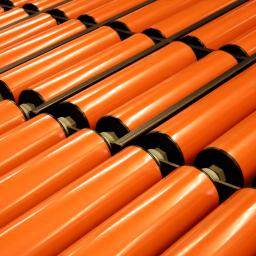Grafenske nanocevi za valjke u boji i transportne trake: kombinacija boja i dugog upotrebnog veka


TUBALL™ nanocevi obezbeđuju stabilne anti-statičke performanse smesama elastomera koje su izrađene od silikona, gume i PU zadržavajući mehaničke osobine i uz minimalni uticaj na matricu domaćina.
TUBALL™ grafenske nanocevi se primenjuju preko aditiva TUBALL™ MATRIX koji se lako koristi, a koji predstavlja liniju koncentrata na bazi polimera i nosača plastifikatora i prethodno disperzovanih TUBALL™ grafenskih nanocevi.
TUBALL™ grafenske nanocevi: dobre performanse za sve ključne parametre
Za razliku od ostalih provodnih agenasa, TUBALL™ grafenske nanocevi su svestrani provodni agens koji nudi dobre performanse za sve ključne parametre.
Tehničke i komercijalne prednosti u silikonskim smesama
|
Parametar |
Provodna čađ* |
MWCNT |
|
|
Radna doza |
10 wt.% |
1–3 wt.% |
1–2 wt.% |
|
Zahtev otpornosti (zapreminska otpornost) |
105–107 Ω•сm |
||
|
Postignuta otpornost (zapreminska otpornost) |
106–109 Ω•сm |
105–107 Ω•сm |
105–107 Ω•сm |
|
Crne tačke na površini |
dostupno samo u crnoj boji |
dostupno samo u crnoj boji |
nepostojeća |
|
Dostupna paleta boja |
nepostojeća |
nepostojeća |
široko |
|
Otpornost ostaje stabilna nakon abrazije površine |
ne |
da |
da |
|
Uticaj na mehaničke performanse |
snažna negativna |
snažna negativna |
nepostojeća |
|
Uticaj na reološka svojstva |
snažna negativna* |
snažna negativna* |
nepostojeća |
|
Formiranje prašine tokom proizvodnje |
da |
da/ne (u slučaju pigmentne disperzije) |
nepostojeća |
|
‘Vrele tačke’ |
da |
moguća |
nepostojeća |
|
Stabilna otpornost u vremenu |
ne |
da |
da |
|
Duži upotrebni vek smese i delova iz kalupa |
ne |
ne |
da |
|
Oslobađanje ugljenika na površini |
da |
nepostojeća |
nepostojeća |
|
Cena anti-statičkih osobina |
uporedno |
uporedno |
uporedno |
* Neophodan dizajn formule (prilagođavanje sistema sušenja)
Ključna prednost 1: Obojene anti-statičke smese
Široka lepeza boja omogućava proizvodnju različitih delova za tržište na kojem su neophodne anti-statičke karakteristike.
Silikoni

Zapreminska otpornost od 103–105 Ω•cm. TUBALL™ 0,2–0,05%
Poliuretani

Interna formulacija za PU kompanije OCSiAl. ASTM D257
Ključna prednost 2: Zadržane mehaničke i anti-statičke osobine
TUBALL™ nanocevi, za razliku od tradicionalnih provodnih agenasa minimalizuju uticaj na elastičnost smesa i parametre zatezanja, viskozitet i reološke osobine.
Rezultati testa u različitim formulacijama: Mehaničke osobine
Veoma male doze TUBALL™ koje su neophodne u EPDM i NBR formulama na bazi silikona omogućavaju postizanje željenih anti-statičkih osobina kao i unapređenja u otpornosti na cepanje i zateznim performansama što se postiže bez degradacije elastičnih osobina i čvrstoće.
EPDM

NBR

PU

Ukoliko je neophodno koristiti materijale pod uslovom deformacije, bitno je zadržati stabilnu otpornost. Uz pomoć TUBALL™ MATRIX, otpornost se održava u okviru ciljanih vrednosti nakon dinamičkog opterećenja.
Aplikacije visokog dinamičkog pritiska – anti-statička LSR sa 1 wt.% TUBALL™ MATRIX 601

Ključna prednost 3: bez oslobađanja ugljenika, smesa koja ne ostavlja tragove
Kada se koristi čađ, usled veće neophodne koncentracije (10% ili više) i sfernog oblika čestica, javlja se fenomen koji je u industriji poznat kao „oslobađanje ugljenika“, gde je provodni aditiv prisutan na površini uzorka.
Sa druge strane, grafenske nanocevi se, zahvaljujući svom većem odnosu dužine i prečnika, ne oslobađaju sa površine.
Ključna prednost 4: standardna opreza za obradu i mešanje
TUBALL™ MATRIX se mora obrađivati standardnom opremom koja se naširoko koristi od strane proizvođača valjaka od gume.
Ostale prednosti
- Veoma mali sadržaj TUBALL™ koji zadržava karakteristike
- Obezbeđenje trajne i uniformisane električne provodljivosti bez „vrelih tačaka“
- Održavanje reologije smesa koje nisu osušene
- Održavanje mekoće i elastičnih osobina
Preuzmite PDF verziju:
Obratite pažnju na smernice za obradu TUBALL™ MATRIX
Video instrukcije za upotrebu:
Conductive colored HCR: Processing guidelines for TUBALL™ MATRIX 605
Anti-static colored EPDM rubbers - Processing guidelines
Primeri primene

NBR transportne trake

Anti-statičke industrijske transportne trake

Mining Rollers
Dodatne informacije
Conductive Silicones - LSR, RTV, HCR and PSA
Conductive elastomers: Prevent negative trade-offs in mechanical properties and color due to SWCNT
A new era?
OCSiAl Introduces New TUBALL MATRIX Products for Elastomers
Kontaktirajte nas da razgovaramo o specifikacijama vašeg projekta ili da poručite uzorak








